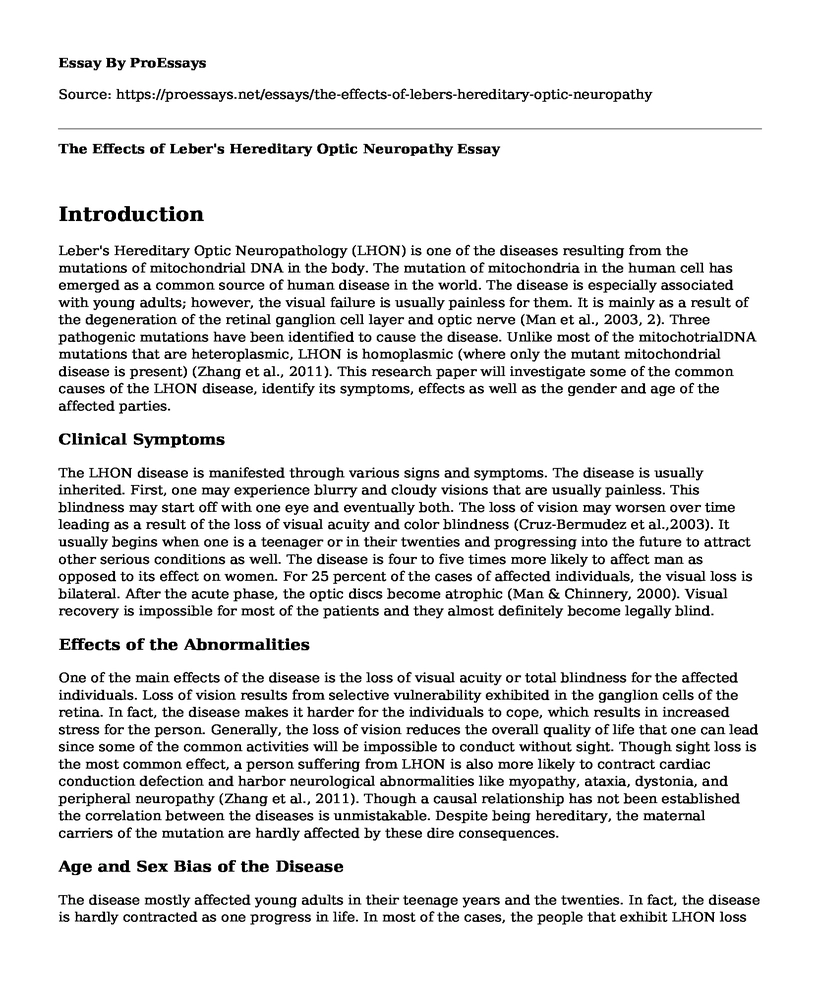Introduction
Leber's Hereditary Optic Neuropathology (LHON) is one of the diseases resulting from the mutations of mitochondrial DNA in the body. The mutation of mitochondria in the human cell has emerged as a common source of human disease in the world. The disease is especially associated with young adults; however, the visual failure is usually painless for them. It is mainly as a result of the degeneration of the retinal ganglion cell layer and optic nerve (Man et al., 2003, 2). Three pathogenic mutations have been identified to cause the disease. Unlike most of the mitochotrialDNA mutations that are heteroplasmic, LHON is homoplasmic (where only the mutant mitochondrial disease is present) (Zhang et al., 2011). This research paper will investigate some of the common causes of the LHON disease, identify its symptoms, effects as well as the gender and age of the affected parties.
Clinical Symptoms
The LHON disease is manifested through various signs and symptoms. The disease is usually inherited. First, one may experience blurry and cloudy visions that are usually painless. This blindness may start off with one eye and eventually both. The loss of vision may worsen over time leading as a result of the loss of visual acuity and color blindness (Cruz-Bermudez et al.,2003). It usually begins when one is a teenager or in their twenties and progressing into the future to attract other serious conditions as well. The disease is four to five times more likely to affect man as opposed to its effect on women. For 25 percent of the cases of affected individuals, the visual loss is bilateral. After the acute phase, the optic discs become atrophic (Man & Chinnery, 2000). Visual recovery is impossible for most of the patients and they almost definitely become legally blind.
Effects of the Abnormalities
One of the main effects of the disease is the loss of visual acuity or total blindness for the affected individuals. Loss of vision results from selective vulnerability exhibited in the ganglion cells of the retina. In fact, the disease makes it harder for the individuals to cope, which results in increased stress for the person. Generally, the loss of vision reduces the overall quality of life that one can lead since some of the common activities will be impossible to conduct without sight. Though sight loss is the most common effect, a person suffering from LHON is also more likely to contract cardiac conduction defection and harbor neurological abnormalities like myopathy, ataxia, dystonia, and peripheral neuropathy (Zhang et al., 2011). Though a causal relationship has not been established the correlation between the diseases is unmistakable. Despite being hereditary, the maternal carriers of the mutation are hardly affected by these dire consequences.
Age and Sex Bias of the Disease
The disease mostly affected young adults in their teenage years and the twenties. In fact, the disease is hardly contracted as one progress in life. In most of the cases, the people that exhibit LHON loss of vision are of the age for young men of about 15 to 25 years. The rate of progression for progression for individuals that contract the disease could be from three to four months to about two years (Man et al., 2003). As a result, the individuals could not engage in such tasks like reading or recognizing faces afterward. The disease is most common to men as compared to women. However, the women are usually affected by the disease at an older age as their levels of estrogen starts to decline (Wei et al., 2017). This indicates that the male carriers are much more likely to be affected by the disease as compared to their female counterparts.
References
Cruz-Bermudez, A., Vicente-Blanco, R. J., Hernandez-Sierra, R., Montero, M., Alvarez, J., Manrique, M. G., & Fernandez-Moreno, M. A. (2016). Functional characterization of three concomitant MtDNA LHON mutations shows no synergistic effect on mitochondrial activity. PloS one, 11(1), e0146816.
Man, P. Y. W. & Chinnery, P. F. (2000). Leber hereditary optic neuropathy. Gene Reviews.
Man, P. Y. W., Griffiths, P. G., Brown, D. T., Howell, N., Turnbull, D. M., & Chinnery, P. F. (2003). The epidemiology of Leber hereditary optic neuropathy in the North East of England. The American Journal of Human Genetics, 72(2), 333-339.
Wei, W., Gomez-Duran, A., Hudson, G., & Chinnery, P. F. (2017). Background sequence characteristics influence the occurrence and severity of disease-causing mtDNA mutations. PLoS Genetics, 13(12), e1007126.
Zhang, A. M., Jia, X., Bi, R., Salas, A., Li, S., Xiao, X., ... & Yao, Y. G. (2011). Mitochondrial DNA haplogroup background affects LHON, but not suspected LHON, in Chinese patients. PloS one, 6(11), e27750.
Cite this page
The Effects of Leber's Hereditary Optic Neuropathy. (2022, Apr 04). Retrieved from https://proessays.net/essays/the-effects-of-lebers-hereditary-optic-neuropathy
If you are the original author of this essay and no longer wish to have it published on the ProEssays website, please click below to request its removal:
- Evidence-Based Practice Paper: Fall Prevention among Patients
- Benefits of Organ Donation Essay
- Humanity and Care for Planet Earth Essay Example
- Essay Example on Help Asthma Patients Gain Knowledge, Confidence, and Skills
- Don't Blame the Eater: Unhealthy Eating Habits and Their Consequences
- Essay Example on Curriculum Dev. & Challenges in Nursing Ed: Examining Trends & Issues
- Hands-Only CPR: A Life-Saving Emergency Technique - Essay Sample







